Your Restaurant’s Turnover Rate Is Costing You Thousands—Here’s What You Can Do About It
It’s really hard to run a restaurant. One of the greatest challenges is retaining their workforce: Restaurants are notorious for having a constantly revolving door of employees.
Employee turnover in the restaurant industry was a staggering 75 percent in 2019, according to the Bureau of Labor Statistics. That percentage is almost twice as high for front-line workers.
Another recent study of 30,000 restaurants reported a turnover of 102 percent for hourly staff at full-service restaurants.
It costs a lot to replace workers. According to research from TDn2K, the cost of turnover is now over $2,000 per employee.
Restaurants must figure out why their staff is leaving and find ways to retain employees in order to run a sustainable and profitable business.
But why is the employee turnover rate so high in the restaurant industry? What are the reasons your employees quit?
To find out, Software Advice surveyed 113 U.S. restaurant servers about their top reasons for leaving their last restaurant job and what could’ve been addressed in order for them to stay.
Here’s what we found:
Poor Compensation Is the Primary Cause of High Employee Turnover
Poor Management and Stress Are the Biggest Industry-Wide Issues
Increasing Pay and Flexibility Are the Most Impactful Ways to Retain Staff
Restaurants Are Missing Key Insights by Not Conducting Exit Interviews
Most Employees Are Open to Staying if Changes Are Implemented
Poor Compensation Is the Primary Cause of High Employee Turnover
As of January 2018, only eight out of 50 states in the U.S. require employers to pay tipped employees the full state-mandated minimum wage. That means a majority of restaurants are allowed to pay workers an hourly rate lower than the minimum wage, leaving waiters to make up the difference in tips.
For an employee at a small to midsize restaurants, low hourly pay creates pressure to get enough tips just to reach minimum wage. Add on the stressful environment common to many restaurants, and you’ll find the top three reasons why waiters left their last restaurant job.
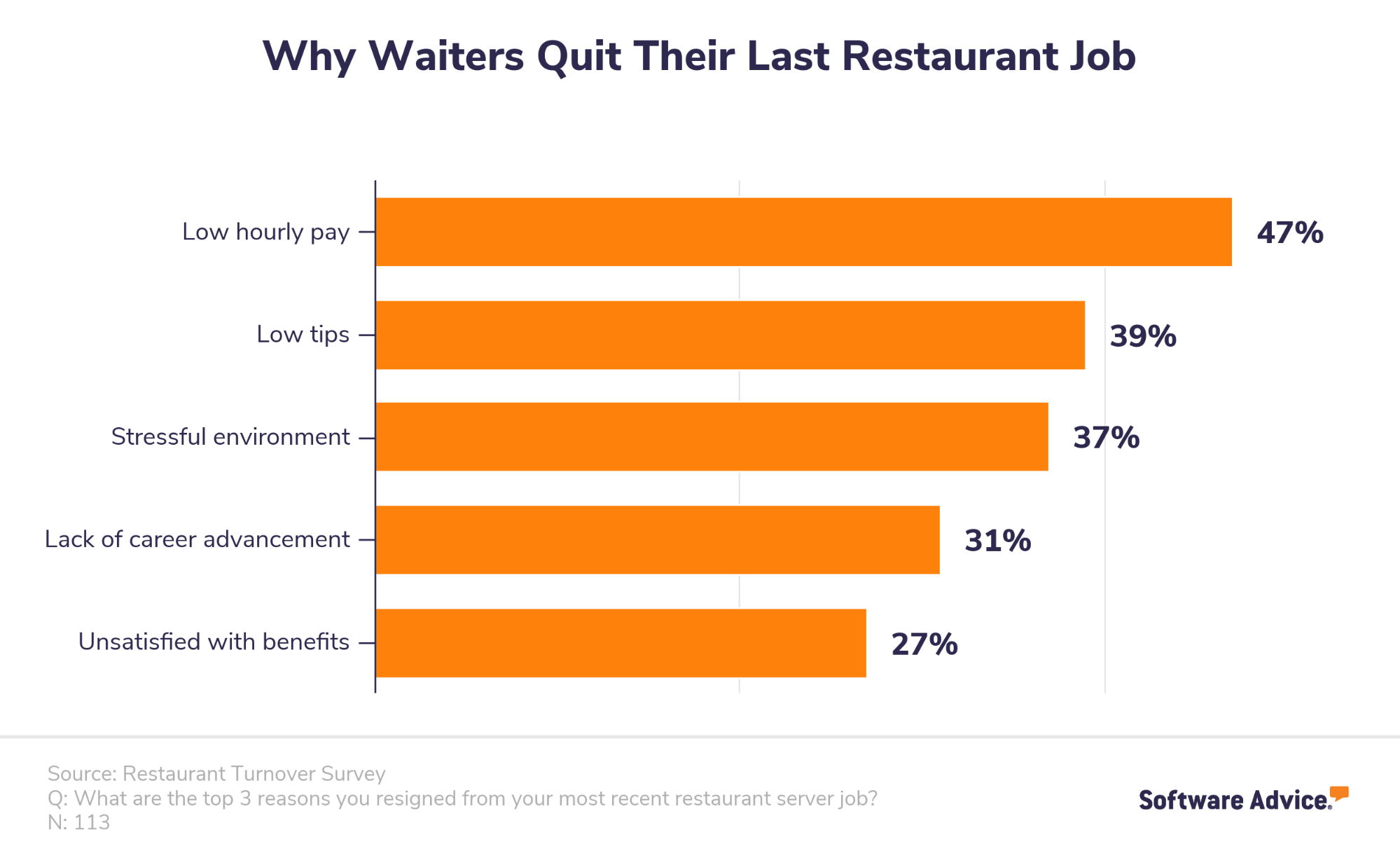
A recent Economic Policy Institute and University of California-Berkeley study found that median hourly earnings for waiters and bartenders average in the country $10.11 an hour, including tips. That’s just $2.86 above the current federal wage floor.
A 2017 study estimated the median hourly wage of servers in the state of Washington, D.C. at $11.86, including tips. That means the average hourly wage of waiters in D.C. was just 36 cents above the minimum wage of $11.50.
As a tipped worker, a server in Washington D.C. receives a base wage of just $3.33 an hour.
“I just think everyone should have that security of knowing they are going to have that paycheck that is going to equal at least a certain amount,” one server told ThinkProgress, adding that since servers at most restaurants would continue to receive tips, their motivation to provide good service wouldn’t change.
KEY TAKEAWAY: To attract talent and pay fair wages to your waiters, restaurant owners must reconsider old business models and come up with innovative ideas to improve employee retention.
Some restaurants have moved toward eliminating tips and offering servers a set pay scale, which can be beneficial to both servers and restaurants, while prompting a new set of challenges.
To address the issue of low hourly pay: A restaurant called Juliet in Somerville, Massachusetts, pays all its staff, excluding management, a single pay scale that is above minimum wage. “We don’t accept tips at the restaurant, the prices are set so everyone earns a fair wage, as staff are put into a profit-sharing pool,” co-owner Josh Lewin told Eater in an interview.
At Juliet, all staff begin at an entry level. “We run them through a series of promotions which come with raises over a period of time, depending on how long they’ve worked at the restaurant and the number of hours they work each week,” says Lewin. Employees are also required to undergo their training program.
He believes this type of personal investment has attracted staff to Juliet and the restaurant has not experienced a shortage of back- or front-of-house applicants.
To address the issue of no tips: Eliminating tips can be a controversial move. Andrea Barton is the owner of LA-based Barcito, which also uses a no-tipping model. She believes that relying on tips creates instability for tipped waiters who can see their incomes fluctuate depending on the diners they serve and hours they work.
“Money earned in tips is unstable and varies each night, and as soon as a restaurant starts to lose its edge, waitstaff tends to abandon ship,” she says in a Medium article.
While Barton acknowledges that challenges still exist, “since we eliminated tipping, Barcito has never had a stronger team of dedicated, passionate employees who love working with one another and push the hospitality envelope on a daily basis,” she says. She also states that the restaurant has experienced “little turnover” since.
How technology can help increase tips
Barcito’s no-tipping business model may not be for everyone. Another approach is to improve your customers’ experience, which will lead to increased tips.
The use of mobile POS, particularly iPad POS technology offerings, can help support customer experience improvements with ease of use and upselling, resulting in greater tips for your employees.
There are ways to do that, such as enabling customers to make their orders or payments over a self-service POS system or iPad. You can highlight specials of the day or other value-adds that will help with upselling and increasing your profitability.
Poor Management and Stress Are the Biggest Industry-Wide Issues
When we asked our survey group about the top three causes of the high turnover rate based on their experience, nearly half of our respondents cited “poor management.”
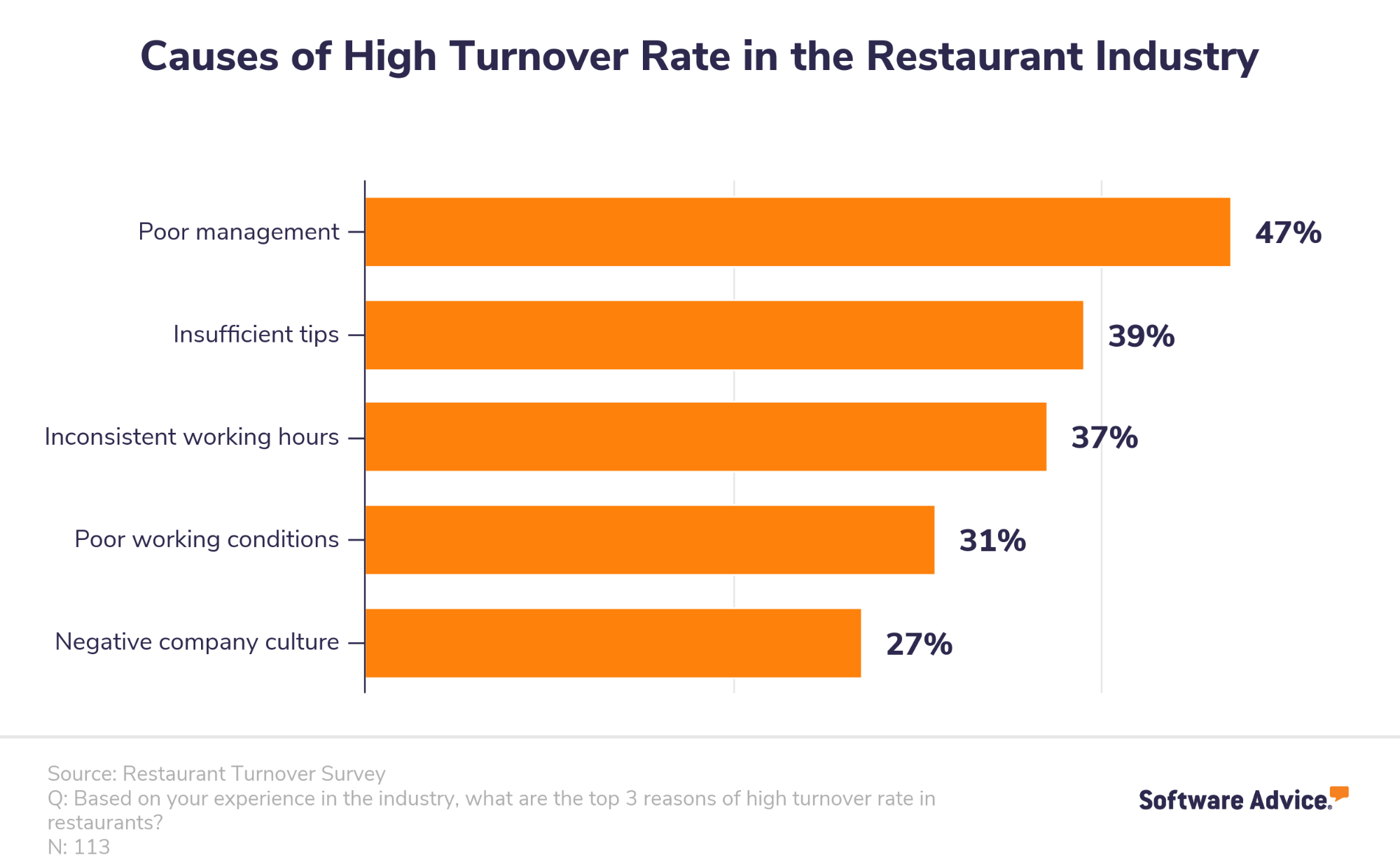
As the saying goes, “people don’t leave jobs, they leave managers,” and our survey shows that to be true.
It may be hard to admit, but if your restaurant is experiencing constant turnover, the reason could be staring you back in the face.
We posed another question to waiters: “Please explain the main reason you resigned from your last restaurant job.”
Once again, compensation emerged as the top reason with over half of our respondents citing it as the main reason, followed by stress and poor management.
Restaurant owners have a lot on their plates. There are countless moving parts that go into pulling off a successful shift. Then there’s the additional stress that comes with a customer complaint, missed orders or a last-minute sick call.
But despite your staff’s shortcomings, their performance—and their likelihood of staying—is typically a reflection of your leadership.
KEY TAKEAWAY: As a restaurant owner, the buck stops with you. Take steps to train your waiters, ensure expectations and communication is clear, and respond quickly to any feedback.
To address the issue of poor management and stress: Have regular ongoing discussions with your waiters about how things went after each shift. Listen to their feedback and ask what you can do to set them up for success.
Research from TDn2K found that continued training from management can lead to decreased turnover. Companies that offer over four or more hours of orientation report nearly 10 percent lower turnover than those that offer fewer than four hours.
Also consider your operations and, more specifically, how your restaurant can benefit from technology dedicated to making your restaurant run much more smoothly.
How technology can help your restaurant’s operations
A restaurant POS can go a long way in simplifying your operations, improving business efficiency and alleviating stress for your employees.
According to our research, 63 percent of single location restaurants still don’t have a POS system in place. There’s no better time than now to start looking into implementing one.
A restaurant POS system will:
Speed up the ordering process.
Enable integration at various stages, starting from when a waiter takes an order to when it’s sent to the kitchen staff, to when the order is ready.
Create real-time reports about transactions.
Provide advanced features for employee scheduling and inventory tracking.
Increasing Pay and Flexibility Are the Most Impactful Ways to Retain Staff
Not surprisingly, respondents surveyed say increasing hourly pay is a key factor in whether they stay at a restaurant. This is followed closely after by flexibility of scheduling, such as the opportunity to work high-traffic and peak hours in order to make more in tips—again, another wage-related matter.
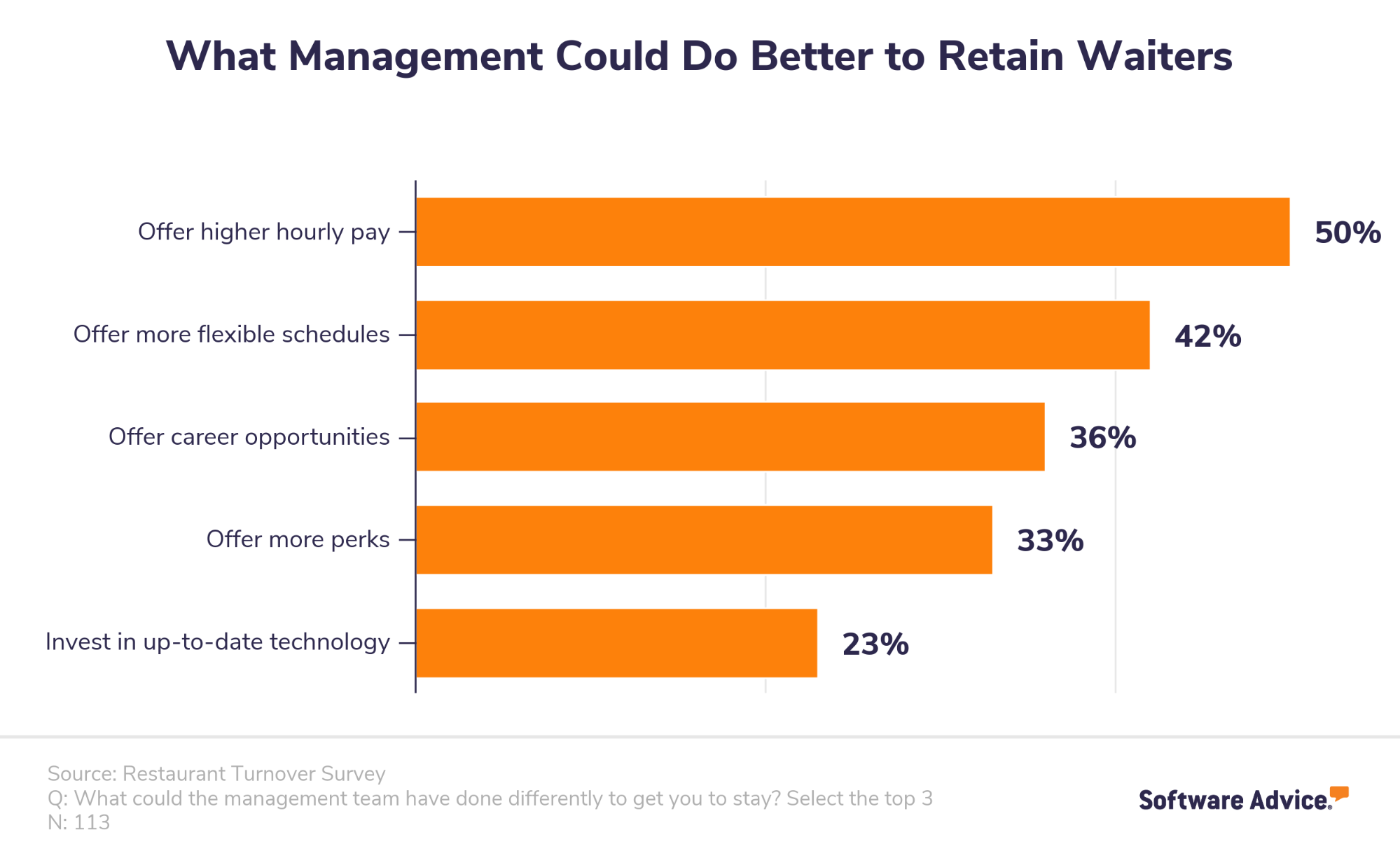
Many respondents surveyed say they struggle to make ends meet. Below are some common complaints:
“I just was not making enough money to sustain myself, even with tips.”
“Very few hours. Not enough money. Found a new job.”
“I was being given too many hours for too little tips. They always scheduled me during down hours.”
“I wasn’t getting enough hours and when I was, the pay was so minimal, despite my bosses always telling me they think I’m the most valuable employee there.”
KEY TAKEAWAY: Research presents a strong business case for raising wages. Think about this: By paying workers more, your restaurants could potentially save money on training costs as a result of lower employee turnover.
In 2008, Molly Moon Neitzel, owner of Molly Moon’s Homemade Ice Cream in Seattle, launched her business while ensuring her employees were paid a livable wage as well as health insurance.
“I had my share of critics; there were plenty of people who said I was crazy, and that I would never be able to make a profit,” says Neitzel. Her business has since grown from one shop with seven employees to over 100 employees with eight ice cream shops.
“What I’ve learned is that taking care of my employees and paying a living wage is absolutely the right thing to do, and it’s also good business strategy,” says Neitzel.
“It’s important for business owners to be aware of the additional costs and rewards that come with raising the minimum wage. I know this may cost me more in the short-term…but the investment will yield significant rewards for my workers, community and my business’ bottom line.”
Molly Moon Neitzel, CEO of Molly Moon’s Homemade Ice Cream
Neitzel found that when minimum wages increase, more families come to their business and their profits go up.
“Since the minimum wage was raised in Seattle, my business has never been better,” she told SeattlePI. “I think it’s been pretty clear that when people in our communities earn more money, they spend more money locally on things like ice cream cones.”
Restaurants Are Missing Key Insights by Not Conducting Exit Interviews
The vast majority of respondents say they did not undergo exit interviews prior to leaving their restaurant jobs.
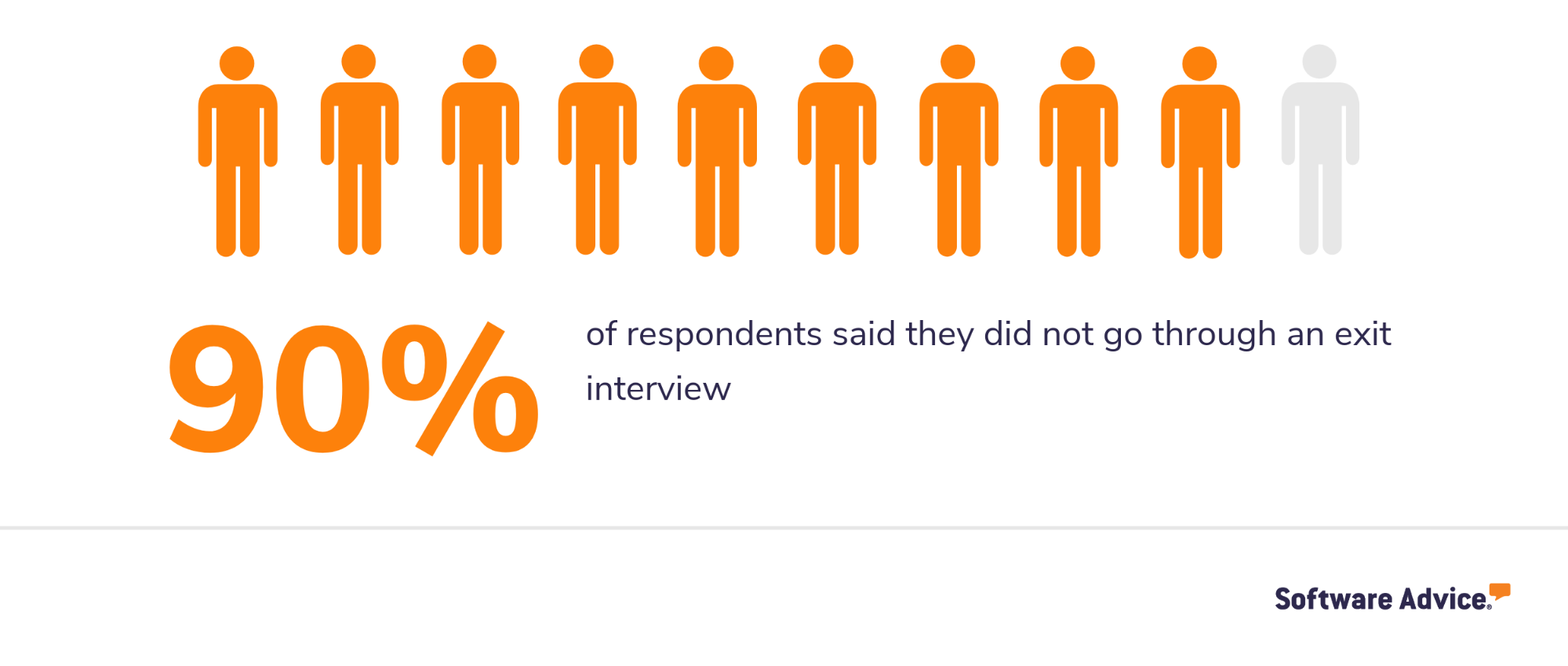
While employee turnover is a natural part of every business, it is too costly to overlook, especially if your restaurant is experiencing high levels of turnover.
KEY TAKEAWAY: There is no better way to learn than from someone who has been in the trenches of the restaurant you run. Exit interviews are crucial for learning what is or isn’t working at the heart of your restaurant.
In addition, they can be used for:
Gaining insight on how to reduce turnover.
Learning what competitors are offering your employees.
Increasing engagement of current employees.
Building an inventory of exit interview data and implementing a strategy to address trending feedback.
Restaurants that aren’t conducting exit interviews are missing out on a unique opportunity to understand why employees are leaving and what improvements can be made.
This checklist will help guide you through the exit interview process:
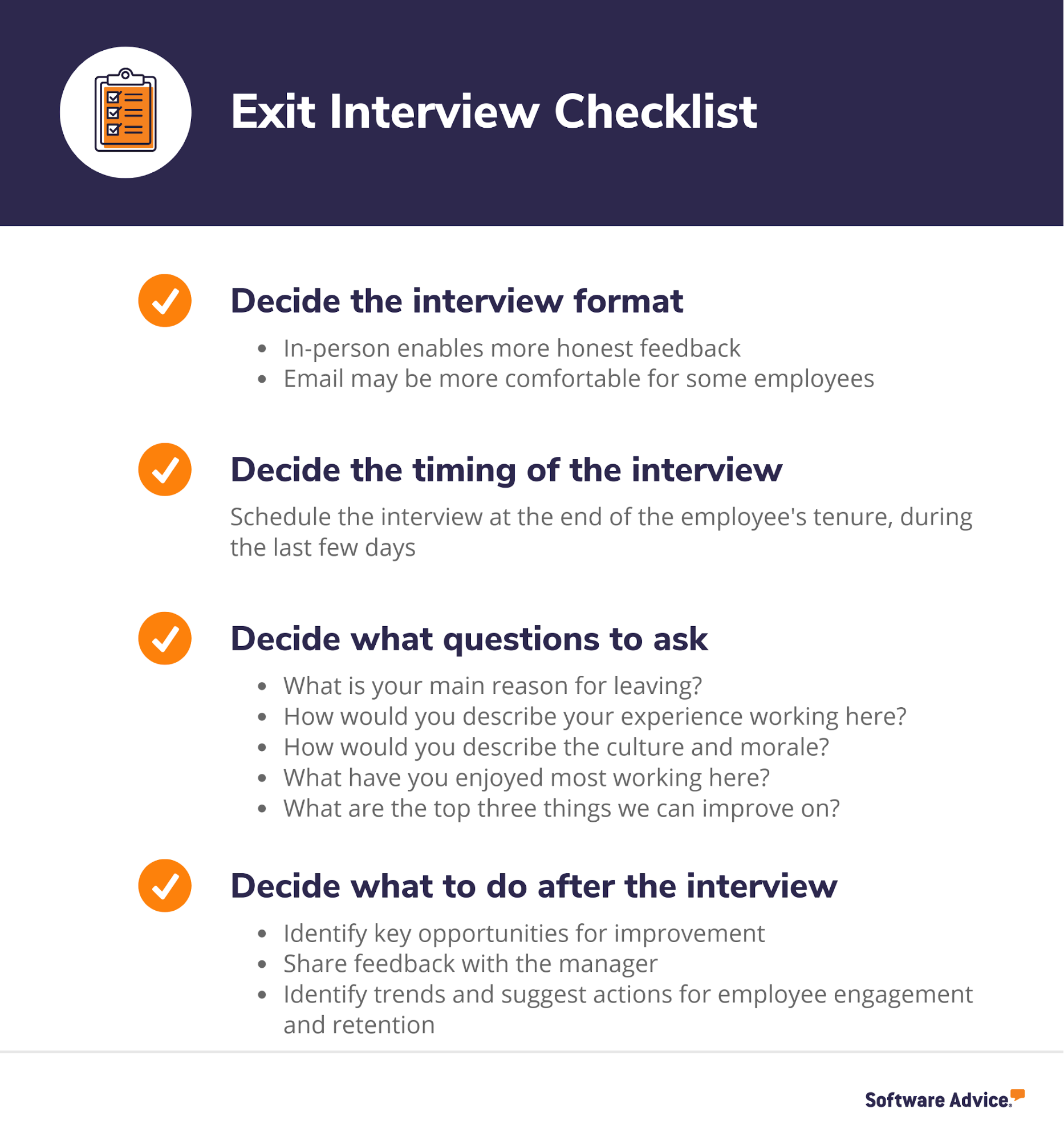
Most Employees Are Open to Staying if Changes Are Implemented
When asked whether they’d be willing to stay at a restaurant if the management made necessary changes to the business’ operations, the majority of respondents replied favorably.
This shows that employees are open to good faith efforts that improve a restaurant’s operations. It also indicates that there’s a strong likelihood that you could keep your best employees if meaningful improvements are made.
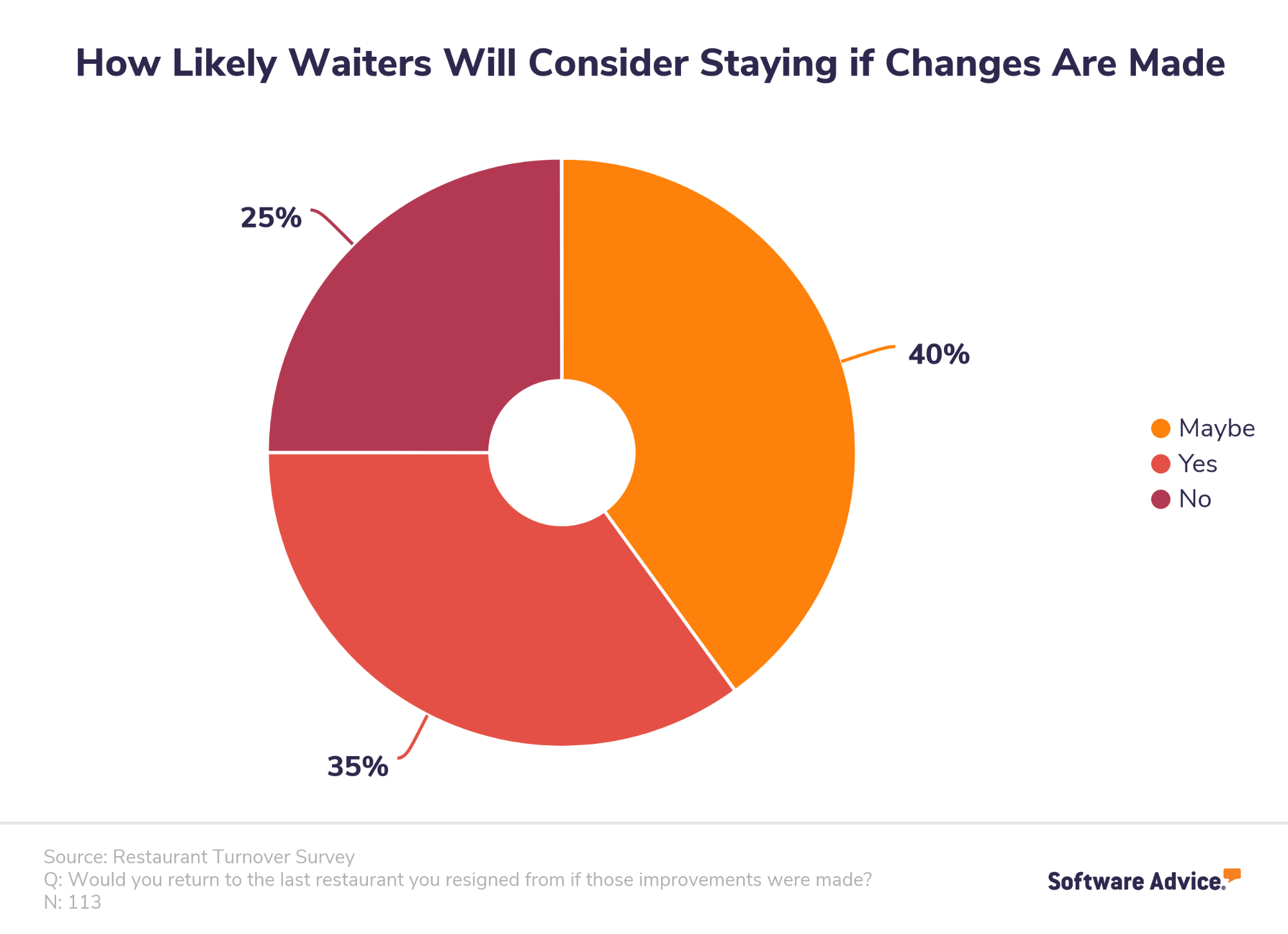
Remember that it costs roughly $2,000 to replace each hourly employee.
When your waiters are leaving for your competitors, you’re forced to spend that and more just to find someone to replace and train them.
Restaurants that have a constant revolving door of employees will find that high turnover rate can devastate their bottom lines.
KEY TAKEAWAY: Retention is the best way to get significant results on your investment into employee training. You can’t build a successful restaurant if your waiters are coming and going all the time.
Focus on investing in your employees and training them for the long term. Also, invest in software like a restaurant POS that can streamline your restaurant’s operations, which will reduce the risk of stress and eventual burnout.
The longer your servers stay, the more skills they’ll acquire, ensuring that you have the most experienced waiters.
The bottom line? Our research clearly shows a correlation between taking care of your employees and improving business results at your restaurant.
Now that you have more insight into the challenges your waiters face—hourly pay, tips and stress—and the ways in which you can address those pain points, you can begin working on improving employee engagement and retaining your star waiters.